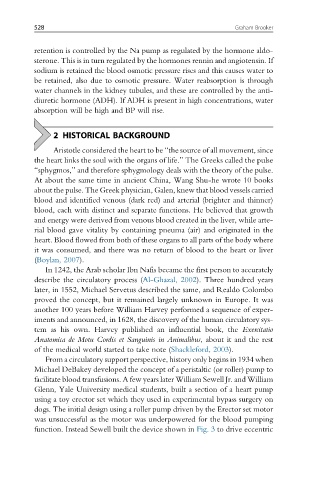Page 534 - Handbook of Biomechatronics
P. 534
528 Graham Brooker
retention is controlled by the Na pump as regulated by the hormone aldo-
sterone. This is in turn regulated by the hormones rennin and angiotensin. If
sodium is retained the blood osmotic pressure rises and this causes water to
be retained, also due to osmotic pressure. Water reabsorption is through
water channels in the kidney tubules, and these are controlled by the anti-
diuretic hormone (ADH). If ADH is present in high concentrations, water
absorption will be high and BP will rise.
2 HISTORICAL BACKGROUND
Aristotle considered the heart to be “the source of all movement, since
the heart links the soul with the organs of life.” The Greeks called the pulse
“sphygmos,” and therefore sphygmology deals with the theory of the pulse.
At about the same time in ancient China, Wang Shu-he wrote 10 books
about the pulse. The Greek physician, Galen, knew that blood vessels carried
blood and identified venous (dark red) and arterial (brighter and thinner)
blood, each with distinct and separate functions. He believed that growth
and energy were derived from venous blood created in the liver, while arte-
rial blood gave vitality by containing pneuma (air) and originated in the
heart. Blood flowed from both of these organs to all parts of the body where
it was consumed, and there was no return of blood to the heart or liver
(Boylan, 2007).
In 1242, the Arab scholar Ibn Nafis became the first person to accurately
describe the circulatory process (Al-Ghazal, 2002). Three hundred years
later, in 1552, Michael Servetus described the same, and Realdo Colombo
proved the concept, but it remained largely unknown in Europe. It was
another 100 years before William Harvey performed a sequence of exper-
iments and announced, in 1628, the discovery of the human circulatory sys-
tem as his own. Harvey published an influential book, the Exercitatio
Anatomica de Motu Cordis et Sanguinis in Animalibus, about it and the rest
of the medical world started to take note (Shackleford, 2003).
From a circulatory support perspective, history only begins in 1934 when
Michael DeBakey developed the concept of a peristaltic (or roller) pump to
facilitate blood transfusions. A few years later William Sewell Jr. and William
Glenn, Yale University medical students, built a section of a heart pump
using a toy erector set which they used in experimental bypass surgery on
dogs. The initial design using a roller pump driven by the Erector set motor
was unsuccessful as the motor was underpowered for the blood pumping
function. Instead Sewell built the device shown in Fig. 3 to drive eccentric

